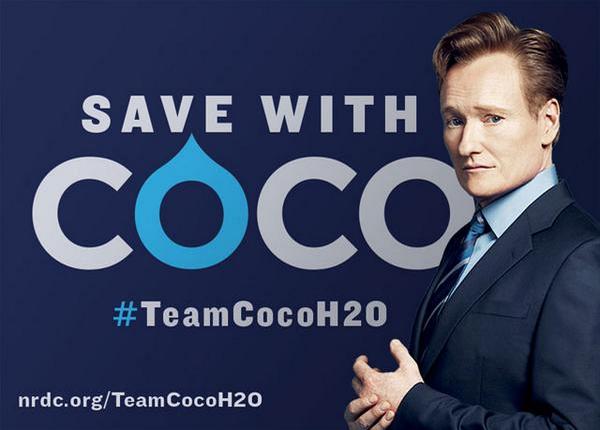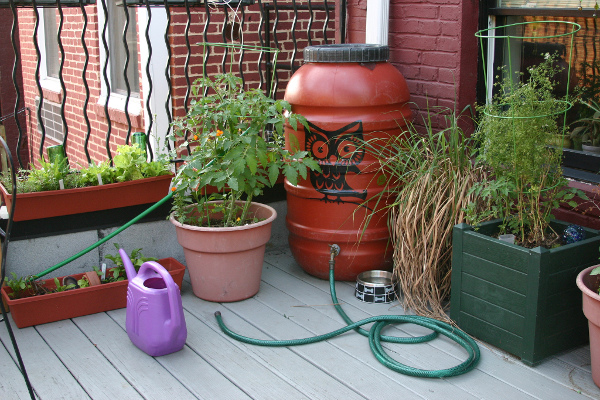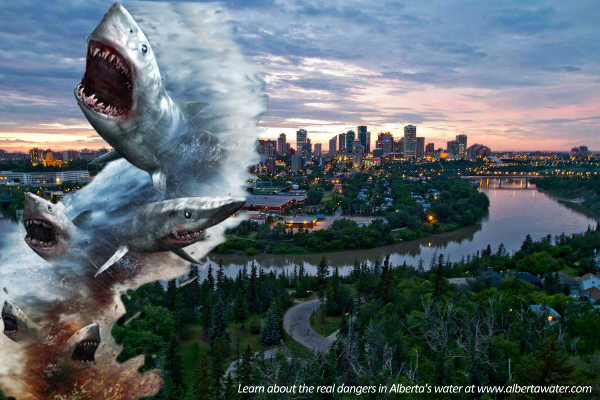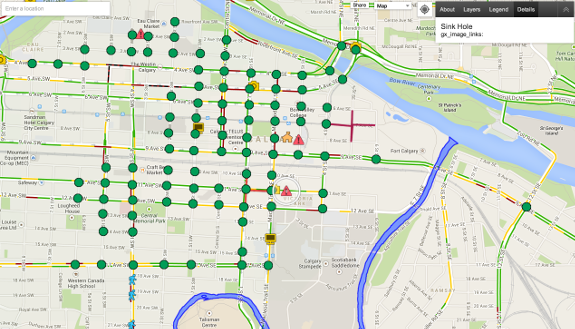Water Saving Tips From Team Coco

Presently, 58 percent of the state of California is experiencing an “exceptional” drought. This is the harshest drought rating, making water conservation practices more necessary than ever before. To communicate the importance of water conservation, the United States Natural Resources Defense Council has partnered with comedians Conan O’Brien and Andy Richter (dubbed “Team Coco”) to get the message out to Californians on how they can save water.
Embedded below is the series of 6 water-conservation videos created by Team Coco. Although Albertans are not the intended audience we’ve shared these videos because regardless of where you live, conserving water should be a priority (plus these videos are pretty funny). That being said Team Coco uses imperial units of measurement so a translation into metric units of measurement has been included below.
Test Your Toilets
- 100 Gallons = 379 Litres
Cover Your Pool
- 40,000 Gallons = 151,416 Litres
Replace Your Lawn With Native Plants
- No units
Use Your Dishwasher
- No units
Take Your Ride To The Carwash
- 60 Gallons = 227 Litres
Being Lazy Has Its Benefits
- No units
Make A Difference – Actions For Individuals To Mitigate Flood and Drought | Storage
Welcome back to our series on actions individuals can take to contribute to flood mitigation on a community level. This week we are looking at water storage using rain barrels.
 |
Photo: “rain barrel” by barbndc is licenced under CC BY 2.0.
Using a Rain Barrel
There are many different ways to mitigate large-scale flooding but the use of dams and reservoirs to store flood waters, particularly using the TransAlta reservoirs, has received a lot of attention[1]. While managing dams is a complex process, the principles around filling and spilling can be applied on a smaller scale. Operating a nano-sized reservoir is a great hands-on learning opportunity for kids at home (or curious adults).
5 Water Films You Should Watch Instead Of Sharknado 2
We are taking a short break from our Actions to Mitigate against Flood and Drought series to talk about Sharknado. Yes, Sharknado…
If you happened to be on Twitter on Wednesday, you might have noticed that the second installment of the movie Sharknado was a trending topic. The campy made-for-TV movie about tornadoes that drop scores of sharks over major American cities has received a lot of media attention. While movies like Sharknado are a fun excuse to suspend reality, we also thought we’d highlight a few alternative acclaimed water-focused documentaries recommended by the water community.

1. Water: A Sacred Relationship
On Wednesday night we asked the following question to our Twitter followers:
Question for our water community: what water movies would you recommend people watch instead of #Sharknado2?
— Alberta WaterPortal (@WaterPortal) July 31, 2014
We would recommend “The Sacred Relationship” – a film about First Nations in Alberta & their relationship with water http://t.co/H3aLHTz8iE
— Alberta WaterPortal (@WaterPortal) July 31, 2014
Our recommendation was the film Water: A Sacred Relationship
The documentary is a part of a broader research and educational project. It is “aimed at using the issue of water to reconcile the relationship between Indigenous people and the rest of Canada”.
Why it is better: Thoughtful dialogue on important issues.
2. The Colorado River: Running Near Empty
“Chasing Water” 12min http://t.co/wUt99p8nCm for those curious about the #ColoradoRiver MT @WaterPortal What water movies would u recommend?
— Korice Moir (@WaterPuppetry) July 31, 2014
Twitter user @WaterPuppetry recommended the film The Colorado River: Running Near Empty, a documentary following photojournalist Peter McBride as he traces the natural course of the Colorado River and explores the human impact on “America’s Nile River”.
Why it is better: The drama is real.
3. Great Canadian Rivers
Well, this just made my night. MT @eFlowsOntario: @WaterPortal Some good #movies about Cdn #rivers here: https://t.co/9Zj6mPcoga @kpassiton
— Korice Moir (@WaterPuppetry) July 31, 2014
British Columbia’s Knowledge Network offers the series Great Canadian Rivers profiling major Canadian Rivers. Choose from a number of videos on Canada’s great river or watch the episode on the Athabasca River available online on August 11th.
Why it is better: It’s local. Sharknado’s only seem to hit American coasts.
4. Watermark
@WaterPortal how about Ed Burtynsky’s film Watermark
— ERWP (@elbow_watershed) July 31, 2014
Our friends at the Elbow River Watershed Partnership suggested Watermark, a stunning film by renowned Canadian photographer Edward Burtynsky.
Why it is better: Unlike Sharknado, Watermark is an award winning film. Sharknado may have been nominated for a People’s Choice award but didn’t win despite the hype.
5. Cold Amazon
Lastly, check out the trailer for the documentary Cold Amazon which showcases Canada’s massive MacKenzie River Basin. Those profiled in the documentary argue that there is still time to protect Canada’s biggest river but the time to act is now.
Cold Amazon: The Mackenzie River Basin – Trailer from WDGF Channel on Vimeo.
Why it is better: You’ll actually learn something.
Any films you would recommend? Are you planning to watch any of these Sharknado alternatives this weekend? Leave a comment below or send us a tweet!
Make A Difference – Actions For Individuals To Mitigate Flood and Drought | Watershed Planning
Our two previous blogs posts focused on how to collect weather data and how to engineer a yard to mitigate against flood and drought. Part three in our “Make A Difference” series focuses on watershed planning. Healthy landscapes are better able to withstand flooding as well as drought and there are numerous organizations in Alberta working to maintain the health of Alberta’s watersheds.
Give time to existing water focused organizations
One of the easiest ways to help mitigate flooding is to donate time to one of the many groups in Alberta that monitor, manage, or help to protect headwater, wetlands, riparian areas, lakes and rivers. The workload of these organizations is growing all the time and increasingly crucial. Many of these groups are volunteer driven and can utilize the help and skills you can bring to the table.
New on the WaterPortal: Alberta Water Research Module
The Alberta WaterPortal is pleased to announce the launch of the Alberta Water Research Module (AWRM). We would like to extend our thanks to Alberta Innovates – Energy and Environment Solutions (AI-EES) for generously helping support the development of this module as well as the relaunch of the Alberta WaterPortal website that occurred back in January.
Long time users of the WaterPortal may remember the previous version of the research module called the Alberta Water Data Module. The Data Module allowed viewers to access real-time data and find reports and information on water in Alberta. The new AWRM incorporates elements of the older version of the data module but has been refocused as an information database. The reports in the older data module are still available and recently released reports have been added to the AWRM.
One new feature of the AWRM is the ability to search article ‘tags’. Tags are helpful if you want to search for a specific subject matter and related terms. If you begin typing a term into the ‘Tags’ box the program will begin to display similar words that have been used to tag articles in the Module.
Make A Difference – Actions For Individuals To Mitigate Flood and Drought | Slowing and Absorbing Rainwater
Welcome to the second installment in our series on how small, individual efforts can positively contribute to flood and drought mitigation. While much attention had been paid to community scale mitigation projects and methods, individuals can still play a role in mitigating floods. Although one person cannot hold back the entirety of future flood waters on their own, engaging in any number of small acts can make some of a difference, especially in smaller scale events.
Engineer Your Garden or Yard
In the 1990s, a group of farmers from Pontbren, England decided to forgo their usual hill farming strategy, which relied on digging ditches and removing hedges or trees. Instead they began to plant shelterbelts and build ponds. Studies found the water in Pontbren was channeled into the ground by (the newly added) tree roots and that the soil under trees acts as a sponge absorbing water 67 times faster than the soil under grass[1][2]. Even more impressive is that the tree soil acts as a reservoir and released water very slowly. If all Pontbren farmers opted for reforestation one study found that peak flooding downstream would be reduced by about 29% and full reforestation would reduce peak flooding by 50% downstream.
Make A Difference – Actions For Individuals To Mitigate Flood and Drought | Collect Data
While much attention had been paid to large community scale mitigation projects and methods, there are opportunities for individuals to play a role in mitigating flooding. To tap into these opportunities the WaterPortal will be sharing a series of blogs entitled “Make A Difference – Actions For Individuals To Mitigate Flood and Drought” which focuses on small, individual efforts that can positively contribute to flood (and drought) mitigation. Spoilers: it all has to do with what we know about, and the health, of our watersheds.
To be very clear, a single person will not be able hold back the entirety of future flood waters on their own. However, enough people engaging in small acts can make a difference, especially in smaller scale events.
Damage from flooding is generally caused by a combination of:
- speed of water
- quantity of water,
- or an insufficient information or data.
The following series of blog posts will present a number of ways individuals can help mitigate future floods along the three ways flood damage occurs.
Measuring Rain, Hail, and Snow
“The Rain Doesn’t Fall The Same On All” – Unknown
How a Calgarian working at Google helped during Alberta’s 2013 flood
As the flood waters rose in 2013 I was tagged in a post from my friend Drew, who works at Google, asking for help finding someone at the City of Calgary who could provide permission to update the Google Crisis Map. Luckily, I was able to help make the needed contact as I continued to update the WaterPortal with the continuously changing information on the flood. One year later, I’ve asked Drew to recount his experience working in the Google Crisis Centre during the Southern Alberta flood of 2013.

My name is Drew Cormier. I was born at Rockyview General Hospital and raised in the Deer River community of Calgary. My summers were filled with street hockey and biking through Fish Creek Park and the winters revolved around building the best snow forts with my friends. Despite moving out of Calgary in 2001, I have always considered it my hometown. More recently, I moved to California to begin working at Google in October of 2012.
In June of 2013, only 7 months after I had begun my new job and life, I started to see disturbing trickles of information pertaining to Calgary through social media. Twitter began to have more and more alerts pertaining to alerts and advisories. Facebook began to fill up with images and videos from friends of flooded streets and evacuations. News websites showed rising water levels at Calgary landmarks like the Saddledome and cars being stranded.
The final push I needed to begin helping was when I saw that the neighborhood I grew up in had been evacuated. The house I was raised in, my friends and their families that I grew up with, had all been evacuated because of the rising Bow River. At that point I knew I had to do something to help.
Flood warning issued for Oldman River and South Saskatchewan River – 2014
A flood warning has been issued for areas in the Oldman Basin and the South Saskatchewan River Sub Basin. This blog entry will be updated as the event unfolds, however we can not guarantee that we will always have the most timely information. For the most up to date details individuals should look to the Alberta Emergency Alerts website, the River Forecast Centre, and their local municipality.
As of June 30th the state of Alberta Emergency Alerts regard this rain and flood event are no longer in effect. Some impacted areas require donations to help with recovery. Check the previous updates for contact information of municipalities to see if they have a call out for additional help.
Calgary Flood Tunnel: What’s Next?
The City of Calgary Expert Management Panel has released The River Flood Mitigation Panel Final Report for approval by City Council. In the report, it’s revealed that the proposed tunnel taking water from the Glenmore Reservoir on the Elbow River to the Bow River will cost $457 million for construction and engineering, double that of the original estimate of $200-290 million. More details are provided in the Report to Priorities and Finance Committee, including that the project has been deemed feasible by the engineering firm Hatch Mott MacDonald.
New In The Report
Aside from a new price tag, the report also comes with a new path for the tunnel. The original proposed path was from the bottom of the Glenmore Reservoir, under 58th Avenue, and into the Bow River. The new path is from within the Glenmore Reservoir, under Heritage Drive, into the Bow River.
Map of possible tunnel diversion routes studied. Heritage Dr was tabbed as optimal route. #yyc #yyccc #cbc pic.twitter.com/3yY6T7TVFV
— Scott Dippel (@CBCScott) June 12, 2014
Reactions So Far…
The report happened to be released (or at least seen by media) mere hours before the Calgary River Communities Action Group Annual General Meeting. For those unfamiliar with the group, they formed shortly after the flood last year and have been advocating for the protection of their communities from future flooding. This meant some raw reactions from that group as they heard not only the news, but the first public comments from Mayor Nenshi and Premier Hancock who were attending the AGM.
River communities advocate calls for a Nenshi Network, a là Winnipeg’s Duff’s Ditch. Now the Glenmore Reservoir tunnel is $457M+, aka “gulp”
— Jason Markusoff (@markusoff) June 13, 2014
Nenshi says unsure Alberta must do Glenmore Tunnel AND McLean dam AND Springbank storage. murmurs in crowd. “Build it!” 1 woman had cried.
— Jason Markusoff (@markusoff) June 13, 2014
Premier Dave Hancock is non-committal on the $500M Glenmore R. tunnel. Says financial sky isn’t the limit, but AB will do what’s necessary
— Jason Markusoff (@markusoff) June 13, 2014
There have also been a trickling in of reactions from those who did not attend the CRCAG AGM.
@mjwagner306 @WaterPortal There will be a plan to disperse the water in Bow but no detail in report.
— Scott Dippel (@CBCScott) June 13, 2014
What are the possible impacts downstream and on the ecology of the river? #BowRivertunnel #abwater @abflood
— Jon Sweetman (@jonsweetman) June 13, 2014
What’s Next?
The report comes with the following recommendation:
|
Recommendation: In partnership with the Province, compare the three major capital works options for mitigating floods on the Elbow River and identify the optimal investment plan: i. A diversion from the Elbow River to the Bow River in accordance with the conclusions of the feasibility studies. ii. The Springbank off-stream diversion and storage site. iii. The McLean Creek dry dam. |
If the recommendation is followed, it seems there may be a winner take-all from the three options above. The report to committee further elaborates on this: “An integrated evaluation by the Province, in collaboration with The City, of the costs and benefits (operational, environmental, economic, safety) of all three options is needed”.
For you the reader, we hope this means now will be the time that you send in feedback on these costs and benefits so that issues that are near and dear to your heart are not missed. Whether that’s the immediate protection of your home, or the trout in river (as per the comments in the tweets above) or something else entirely. As indicated in previous blog posts, we can be your messenger to get feedback to report writers and decision makers. Alternatively you can send feedback directly to the City or Province.
